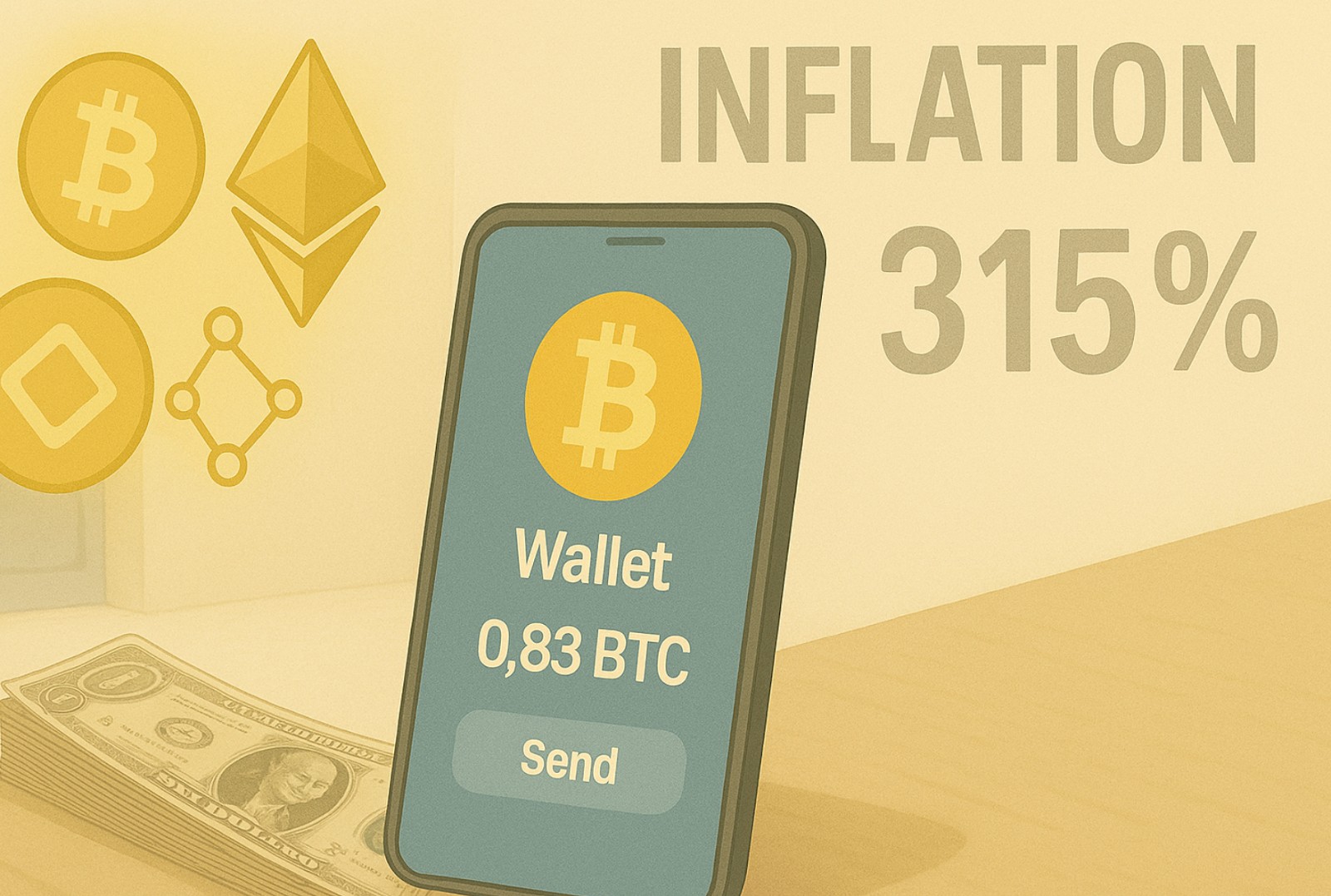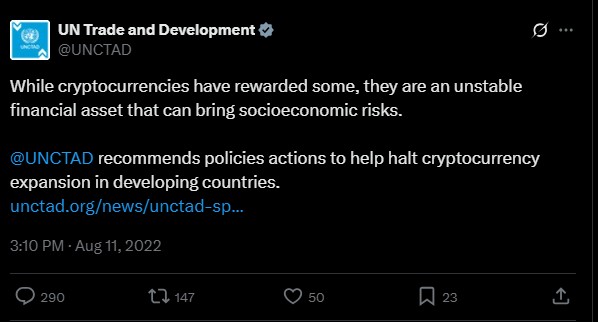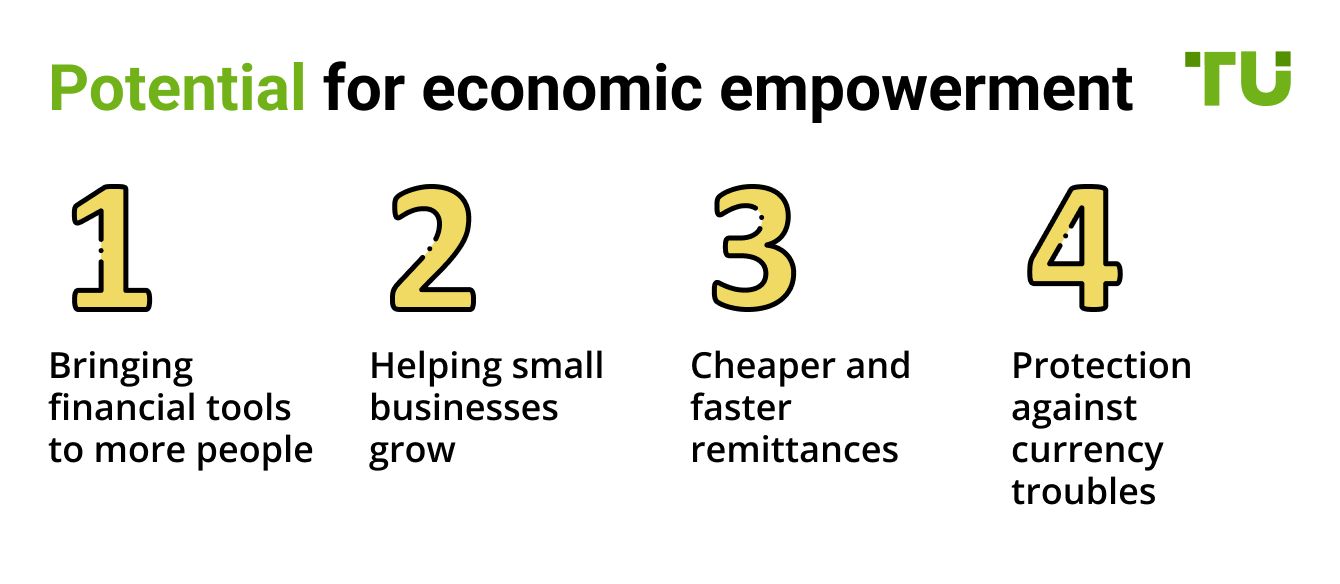How Crypto Is Powering Survival In Fragile Economies



Editorial Note: While we adhere to strict Editorial Integrity, this post may contain references to products from our partners. Here's an explanation for How We Make Money. None of the data and information on this webpage constitutes investment advice according to our Disclaimer.
Cryptocurrencies and blockchain technology are increasingly playing a role in supporting individuals and businesses in fragile economies by offering alternative financial tools and potentially mitigating economic crises. They provide mechanisms for remittances, store-of-value, and even financial inclusion, especially in areas with unstable currencies or limited access to traditional banking.
In fragile economies, crypto is not some risky bet. It is a tool people turn to when everything else fails. When money loses value fast and prices jump before payday, people stop thinking about profit and start thinking about how to stay afloat. They use stablecoins to buy food, skip government limits, or send money back home when banks barely work. And that changes everything. In these places, people use crypto for different reasons than in richer countries. It is no longer about buzz. It is now part of daily life.
Risk warning: Cryptocurrency markets are highly volatile, with sharp price swings and regulatory uncertainties. Research indicates that 75-90% of traders face losses. Only invest discretionary funds and consult an experienced financial advisor.
Understanding economic instability and its impact on traditional finance

Economic instability, marked by hyperinflation, currency devaluation, capital controls, and banking restrictions, can significantly disrupt traditional financial systems. These conditions interfere with financial planning, weaken investor confidence, and put pressure on the stability and effectiveness of banking institutions.
Hyperinflation, defined as inflation exceeding 50% per month, leads to a rapid decline in the value of a currency. Notable historical examples include Zimbabwe in the late 2000s and Germany in the 1920s. In such cases, savings lose value quickly, pricing becomes unreliable, and overall economic stability deteriorates.
Currency devaluation also poses serious risks. When a country’s currency loses value against others, the cost of imports rises, which can trigger imported inflation. Devaluation can also increase the burden of debt that is denominated in foreign currencies and discourage foreign investment due to increased exchange rate volatility.
Capital controls and banking restrictions
Governments may implement capital controls to manage the movement of money across borders, particularly during times of economic stress. These measures are designed to stabilize the domestic economy and can include tools such as taxes, tariffs, restrictions on currency exchange, or limitations on foreign investments.
Although capital controls are intended to shield the economy, they often have unintended consequences. Such restrictions can discourage foreign investment and limit access to international capital markets. Banking measures like withdrawal limits or account freezes may also weaken public confidence in financial institutions, driving individuals and businesses to seek alternative financial systems or store value in assets outside the traditional banking sector.
The role of cryptocurrencies as alternative financial tools
Cryptocurrencies have grown into popular alternatives to traditional financial systems. They are now used not only for investment and savings but also for everyday spending, especially in regions where conventional banking falls short.
Bitcoin is often compared to gold because of its limited supply. With only a fixed number of coins that can ever be created, and no central authority controlling its issuance, many view it as a long-term store of value. This comparison has led to increased interest from institutions. In 2025, for example, the U.S. government established a Strategic Bitcoin Reserve, which now holds approximately 200,000 BTC. While Bitcoin is widely used for holding value, it remains highly volatile. Investors should be aware of the risks involved and stay informed about market trends before making long-term commitments.
Stablecoins have emerged as a more practical option for daily use. These digital assets are typically pegged to fiat currencies like the U.S. dollar, which helps maintain a steady value and avoids the price swings associated with other cryptocurrencies. This stability makes them suitable for routine activities such as saving, spending, and sending money.
People around the world use stablecoins to pay for services, transfer funds across borders, and manage small transactions. They often move faster and cost less than traditional methods like wire transfers or remittance services. In areas with limited access to banking, stablecoins offer a simple entry point to financial tools. All that is required is a smartphone and an internet connection, making them accessible in both urban centers and remote communities.
Case studies: Cryptocurrency adoption in select countries

When traditional financial systems falter, people often turn to alternatives. In countries such as Venezuela, Nigeria, and Turkey, cryptocurrencies have emerged as a practical solution for dealing with inflation, currency devaluation, and restrictions on personal finance.
In Venezuela, the widespread adoption of stablecoins has become a way for citizens to protect their savings. With the bolívar rapidly losing value, stablecoins offer a more reliable store of value. Between July 2023 and July 2024, nearly half of all small payments in the country were made using stablecoins. As a result, overall crypto activity surged by more than 100% in 2024, reaching approximately $20 billion. By using stablecoins, Venezuelans have been able to bypass the volatility of their local currency.
In Nigeria, everyday use of cryptocurrency is increasingly common. The country ranks among the top globally for crypto adoption, recording about $59 billion in crypto movement over the course of a year. Most of these transactions are small, suggesting that crypto is being used for routine financial activities such as bill payments and money transfers. In response to this trend, lawmakers in 2024 called for regulatory frameworks to make the space safer for users.
Turkey presents another example of crypto’s role in a struggling economy. Faced with rising inflation, the country saw its central bank raise interest rates to 46% in 2025 in an attempt to stabilize the lira. Despite these efforts, the national currency remained volatile. As a result, many Turkish citizens turned to crypto assets to preserve the value of their savings. With more than $130 billion in crypto trades, Turkey has become one of the largest cryptocurrency markets in the world.
Benefits and challenges of crypto adoption in unstable economies
Cryptocurrencies are becoming popular in countries with shaky economies. They offer new ways to manage money and send funds across borders. But they also come with their own set of problems, especially when it comes to rules and safety.
The table below outlines some of the key benefits and challenges cryptocurrencies offer:
| Benefits | Challenges |
|---|---|
| Access to financial services in underserved regions via smartphone and internet | Lack of clear regulations increases risk of scams and fraud |
| Faster and cheaper cross-border money | High price volatility makes value unpredictable |
| Empowers users with more control over their finances in unreliable banking environments | Security risks such as hacking or loss of access credentials |
The future of cryptocurrencies in emerging markets
In many emerging economies, crypto is more than a trend. It's a tool people are using to solve real problems. From sending money faster to building small businesses, crypto is opening new doors. As these technologies mature, they could play a big role in shaping a fairer and more flexible financial system.
Potential for economic empowerment

Bringing financial tools to more people
In many developing countries, millions of people don't have access to banks. Crypto gives them a way to save, send, and receive money using just a phone and internet.
With a digital wallet, someone can take part in the global economy even without a local bank.
Helping small businesses grow
Crypto makes it easier for local entrepreneurs to raise funds, even in small amounts, through things like crowdfunding.
It also allows them to receive payments from customers all over the world, without relying on traditional payment systems that charge high fees or have slow settlement times.
Cheaper and faster remittances
Families in emerging markets rely heavily on money sent from abroad. But traditional remittance services often charge high fees.
With crypto, these transfers can be quicker and cheaper, meaning more of the money actually reaches those who need it.
Protection against currency troubles
In countries with unstable currencies, crypto offers an alternative way to hold value.
People use stablecoins or Bitcoin to avoid the effects of inflation or sudden currency crashes.
Integration with traditional financial systems
Banks and crypto working together
Some banks are starting to offer services that include crypto, like letting customers buy and hold digital assets or use crypto-based loans.
These partnerships are bringing together the best of both worlds — traditional finance's trust and reach, and crypto's speed and flexibility.
Rise of digital national currencies
Central banks in countries like India, Brazil, and Nigeria are testing their own digital currencies.
These Central Bank Digital Currencies, or CBDCs, are aimed at making everyday payments faster, more transparent, and less reliant on cash.
Creating smart rules
As crypto use grows, countries are beginning to shape clearer rules.
Good regulations can encourage new ideas while keeping users safe from scams and unstable projects.
Encouraging local innovation
With better infrastructure and policy support, local startups in emerging markets are building new crypto-based tools tailored to their unique needs.
This grassroots innovation could lead to solutions that work better than imported ones from bigger economies.
Why crypto adoption under pressure teaches the real use case
If you are just getting into crypto and want to know how it works in countries where money is shaky, don’t look at charts — look at where the money actually moves. In places like Argentina or Lebanon, people rush into stablecoins not to trade the dip, but to keep what little they have safe. When the currency crashes, people trade fast through group chats. This is not about timing the market. It is about trying to stay one step ahead of collapse. If you want to learn what crypto really does, watch the people who use it under pressure — not the ones tweeting about the next pump.
Another thing that surprises most outsiders is how people actually use crypto day to day. Wallets get passed around. Families share accounts. Street vendors might ask you to scan a QR code they got from their cousin. That would sound risky to crypto hardliners. But when no one trusts the system, people build their own. Telegram turns into a trading hub. Even messaging apps become money tools. If you are building or investing in this space, forget the polished apps and dashboards. Real crypto lives between neighbors trying to buy bread with what they earned before inflation wipes it out.
Conclusion
What really matters with crypto shows up when things fall apart. In unstable places, it is not about coins or hype. It is about keeping money from disappearing. Crypto does not magically fix broken systems. But when banks and cash break, people figure out their own way. That is when crypto turns into something real. A way to get by. If you want to know where this is really going, stop looking at the headlines. Start looking at how people keep going when everything else stops working.
FAQs
Can stablecoins replace local currencies in daily transactions?
Yes, in many unstable economies, stablecoins like USDT are already used for everyday payments due to their stability and ease of access compared to local currencies.
How are governments responding to increased crypto adoption?
Governments are introducing regulations like the U.S. STABLE Act and exploring their own digital currencies to maintain monetary control and ensure financial system stability.
Can adoption of stablecoins be detrimental for unstable economies?
Yes, stablecoin adoption can weaken a country's monetary authority, reduce tax collection efficiency, and increase exposure to external economic influences.
Which stablecoin is adopted the most by unstable economies?
USDT is the most widely adopted stablecoin in unstable regions, followed by DAI in countries like Argentina where people seek protection from currency devaluation.
Related Articles
Team that worked on the article
Anton Kharitonov is an active trader and analyst. He employs both short- and long-term trading strategies, primarily based on fundamental factors, supported by technical indicators and intermarket analysis. Anton trades major and minor currency pairs, while his primary focus is on oil futures and index CFDs.
As a financial expert and analyst at Traders Union since 2013, Anton performs thorough internal broker evaluations, referred to as “test drives.” He examines website and account interfaces, client support, software stability, deposit and withdrawal processing speed, legal documentation, and additional broker services such as VPS, affiliate programs, contests, bonuses, and training programs.
New knowledge is the key to expanding our horizons and unlocking new opportunities. Every step in learning, every new understanding empowers us become better, smarter, and stronger. Knowledge provides an advantage, enabling informed decisions, confident actions, and forward momentum. In a changing world, only those who embrace learning and adaptation can truly thrive.
Based on these evaluations, Anton prepares expert reports on the operation of Forex, stock, binary options, and cryptocurrency exchanges.
Chinmay Soni is a financial analyst with more than 5 years of experience in working with stocks, Forex, derivatives, and other assets. As a founder of a boutique research firm and an active researcher, he covers various industries and fields, providing insights backed by statistical data. He is also an educator in the field of finance and technology.
As an author for Traders Union, he contributes his deep analytical insights on various topics, taking into account various aspects.
Mirjan Hipolito is a journalist and news editor at Traders Union. She is an expert crypto writer with five years of experience in the financial markets. Her specialties are daily market news, price predictions, and Initial Coin Offerings (ICO).
CFD is a contract between an investor/trader and seller that demonstrates that the trader will need to pay the price difference between the current value of the asset and its value at the time of contract to the seller.
Forex leverage is a tool enabling traders to control larger positions with a relatively small amount of capital, amplifying potential profits and losses based on the chosen leverage ratio.
Volatility refers to the degree of variation or fluctuation in the price or value of a financial asset, such as stocks, bonds, or cryptocurrencies, over a period of time. Higher volatility indicates that an asset's price is experiencing more significant and rapid price swings, while lower volatility suggests relatively stable and gradual price movements.
Bitcoin is a decentralized digital cryptocurrency that was created in 2009 by an anonymous individual or group using the pseudonym Satoshi Nakamoto. It operates on a technology called blockchain, which is a distributed ledger that records all transactions across a network of computers.
Index in trading is the measure of the performance of a group of stocks, which can include the assets and securities in it.






























































































































